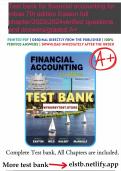Exam (elaborations)
Test bank for financial accounting for mbas 7th edition easton
DOWNLOAD THE Test Bank for Financial Accounting for MBAs 7th Edition Easton Module 1 Financial Accounting for MBAs Learning Objectives – Coverage by question True/False Multiple Choice Exercises Problems LO1 – Explain and assess the four main business activities. Essays 1 LO2 – Identify and d...
[Show more]




